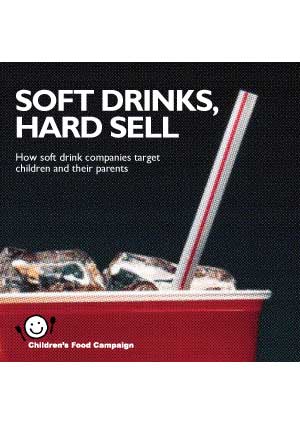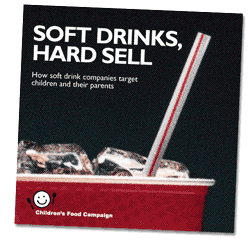
Soft Drinks, Hard Sell: How soft drink companies target children and their parents
24pp - 2011 | 1117Kb

Soft Drinks, Hard Sell: How soft drink companies target children and their parents
24pp - 2011 | 1117Kb
 The Children's Food Campaign conducted a survey of the summer’s soft drink marketing campaigns in 2011 that are likely to appeal to children and their parents. We compared the products with their marketing messages, across a range of brands, and found that in several cases, companies were using misleading marketing to sell more soft drinks to children.
The Children's Food Campaign conducted a survey of the summer’s soft drink marketing campaigns in 2011 that are likely to appeal to children and their parents. We compared the products with their marketing messages, across a range of brands, and found that in several cases, companies were using misleading marketing to sell more soft drinks to children.
In 2010, UK consumption of soft drinks grew by 4.1 per cent to reach 14.6 billion litres. This means that the average person now consumes 234 litres per year or 642ml per day: the equivalent of almost two standard (330ml) cans. As a result the soft drinks sector grew by 5.8 per cent that year, to become a £13.9 billion industry, the fastest annual rate of growth in the last seven years. Manufacturers have been investing heavily in their products and their marketing through a range of tactics.
This report shows that the soft drinks market is a lucrative one, and companies have millions of pounds to spend on marketing their products, including to children and their parents. Unfortunately, we believe that many of these marketing messages are misleading, and we believe they are encouraging parents and children to consume drinks that contradict public health advice. As a result, the report recommends that Government should:
Report contents
Introduction
What we did
Examples
Conclusion and recommendations
References
Children's Food Campaign: Campaigning for policy changes so that all children can easily eat sustainable and healthy food.
Sustain
The Green House
244-254 Cambridge Heath Road
London E2 9DA
020 3559 6777
sustain@sustainweb.org
Sustain advocates food and agriculture policies and practices that enhance the health and welfare of people and animals, improve the working and living environment, promote equity and enrich society and culture.
© Sustain 2025
Registered charity (no. 1018643)
Data privacy & cookies
Icons by Icons8